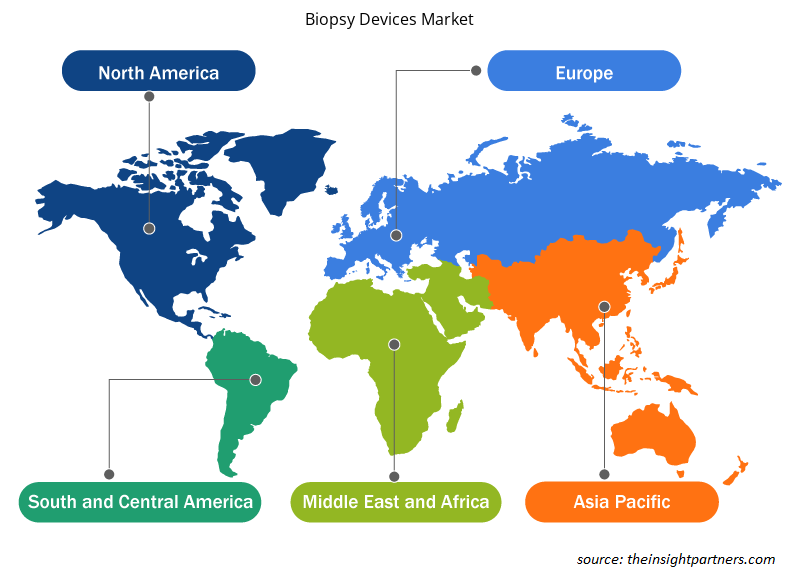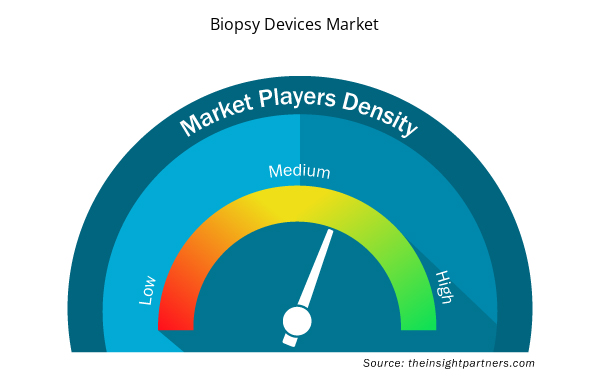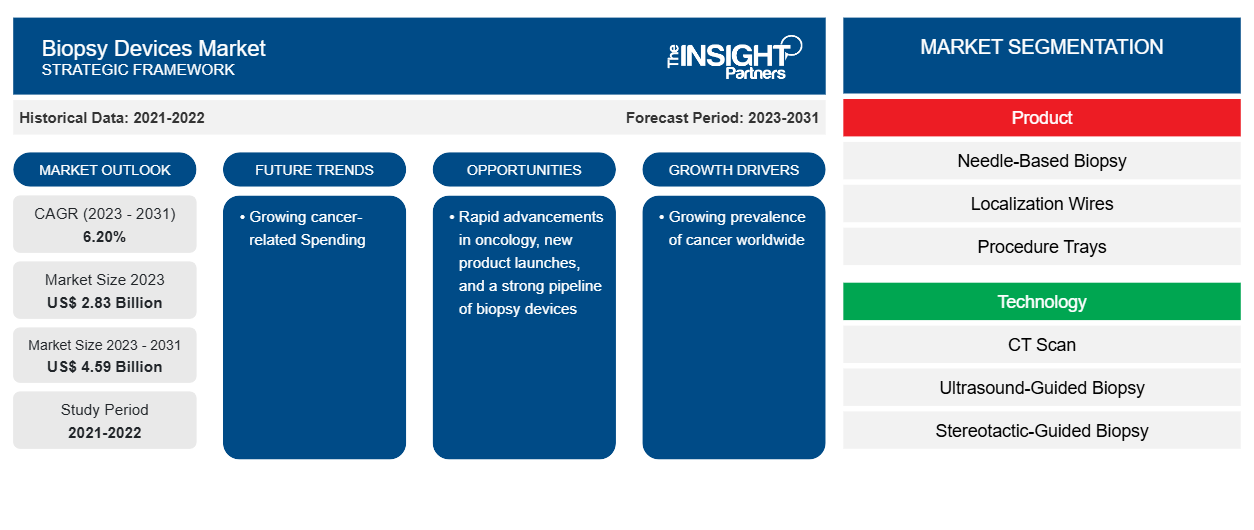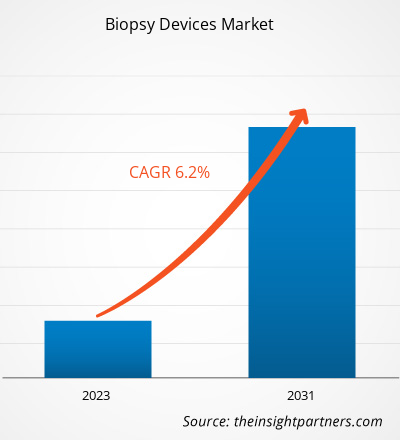活检设备市场规模预计将从 2023 年的 28.3 亿美元增至 2031 年的 45.9 亿美元。预计 2023-2031 年该市场的复合年增长率为 6.20%。癌症病例的增加、活检数量的增加以及活检设备的技术进步可能仍是活检设备市场的主要趋势。
活检设备市场分析
人们对微创手术的偏好日益增加、癌症病例数量不断增加以及政府为癌症诊断采取的举措等因素正在推动市场增长。活检是乳腺癌、皮肤癌和前列腺癌等各种癌症类型的主要诊断技术之一。根据泛美卫生组织的数据,预计未来二十年癌症负担将增加约 60%。预计到 2040 年,全球癌症负担将增加到约 3000 万例新癌症病例,尤其是在中低收入国家。因此,随着癌症病例发病率的增加和活检设备技术的进步,预计市场将在预测期内增长。
活检设备市场概况
北美是活检设备市场增长的最大市场,其中美国占有最大的市场份额,其次是加拿大。对微创活检手术的需求不断增长等因素也是北美活检设备市场增长的关键因素。根据美国整形外科医师协会 2022 年发布的数据,美国进行了约 23,672,269 例美容微创手术。因此,这些手术需要活检设备,这反过来又推动了市场增长。
定制此报告以满足您的需求
您可以免费定制任何报告,包括本报告的部分内容、国家级分析、Excel 数据包,以及为初创企业和大学提供优惠和折扣
- 获取此报告的关键市场趋势。这个免费样品将包括数据分析,从市场趋势到估计和预测。
活检设备市场驱动因素和机遇
癌症发病率上升 活检设备需求旺盛 系统利好市场
全球癌症负担的不断增加是全球活检设备市场的一个重要驱动因素。癌症诊断需要精确和早期识别才能获得最佳治疗,因此活检是一种必不可少的诊断工具。根据世界卫生组织的数据,2022 年,预计新增癌症病例 2000 万例,死亡人数 970 万,约有五分之一的人在一生中患上癌症。因此,活检设备在恶性组织识别中变得至关重要,可帮助医生制定治疗策略。
活检设备的技术进步——活检设备市场的机遇
医疗器械的技术进步和快速创新是另一个主要的增长诱因。随着这些进步和创新,活检程序的有效性、速度和安全性多年来得到了提高。例如,真空辅助活检设备有助于更快、更舒适地提取组织样本。此外,CT 扫描、超声波或 MRI 等实时成像技术与活检设备的集成为医生提供了更准确的目标区域、更少的程序并发症和更高的诊断可靠性。这些技术进步有助于提高医疗保健专业人员的产品采用率,从而推动活检设备市场的增长。
活检设备市场报告细分分析
有助于得出活检设备市场分析的关键部分是产品、技术和应用。
- 根据产品,活检设备市场细分为针式活检、定位导线、手术托盘和其他。针式活检设备在 2023 年占据了更大的市场份额。针式活检设备因其精度高、损伤小等优势而日益普及,推动了该细分市场的市场增长。
- 根据技术,市场分为 CT 扫描、超声引导活检、立体定向引导活检、MRI 引导活检和其他。超声引导活检领域在 2023 年占据了最大的市场份额。然而,CT 扫描领域在预测期内的复合年增长率最快。
- 根据活检设备的应用,市场细分为肺活检、肾活检、肝活检、乳房活检和其他。乳房活检部分在 2023 年占据了最大的市场份额。
活检设备市场份额按地区分析
活检设备市场报告的地理范围主要分为五个地区:北美、亚太、欧洲、中东和非洲、南美/南美和中美。
North America has dominated the Biopsy Devices Market. The market growth can be attributed to the rising adoption of Biopsy Devices for various applications, the rising prevalence of cancer cases, the presence of major manufacturers involved in manufacturing Biopsy Devices systems, and the investment by pharma and biotech companies for medical devices in North American countries. For instance, according to the data published by the Pan America Health Organization (PAHO), Cancer is the second cause of morbidity and mortality in the Americas, after cardiovascular disease. An estimated 4 million people were newly diagnosed and 1.4 million people died from cancer in 2020. Hence, the increasing number of diagnosed cancer population will demand biopsy devices, in turn will fuel the market growth.
Biopsy Devices Market Regional Insights
The regional trends and factors influencing the Biopsy Devices Market throughout the forecast period have been thoroughly explained by the analysts at Insight Partners. This section also discusses Biopsy Devices Market segments and geography across North America, Europe, Asia Pacific, Middle East and Africa, and South and Central America.

- Get the Regional Specific Data for Biopsy Devices Market
Biopsy Devices Market Report Scope
| Report Attribute | Details |
|---|---|
| Market size in 2023 | US$ 2.83 Billion |
| Market Size by 2031 | US$ 4.59 Billion |
| Global CAGR (2023 - 2031) | 6.20% |
| Historical Data | 2021-2022 |
| Forecast period | 2023-2031 |
| Segments Covered | By Product
|
| Regions and Countries Covered | North America
|
| Market leaders and key company profiles |
|
Market Players Density: Understanding Its Impact on Business Dynamics
The Biopsy Devices Market market is growing rapidly, driven by increasing end-user demand due to factors such as evolving consumer preferences, technological advancements, and greater awareness of the product's benefits. As demand rises, businesses are expanding their offerings, innovating to meet consumer needs, and capitalizing on emerging trends, which further fuels market growth.
Market players density refers to the distribution of firms or companies operating within a particular market or industry. It indicates how many competitors (market players) are present in a given market space relative to its size or total market value.
Major Companies operating in the Biopsy Devices Market are:
- BD
- QIAGEN
- Hologic
- Bio-Rad Laboratories
- Cardinal Health
- Medtronic plc
免责声明:上面列出的公司没有按照任何特定顺序排列。

- 了解活检设备市场的主要参与者概况
活检设备市场新闻和最新发展
活检设备市场通过收集主要和次要研究后的定性和定量数据进行评估,其中包括重要的公司出版物、协会数据和数据库。以下是活检设备市场的发展列表:
- TransMed7, LLC 宣布 Heron XPS 设备的商业化生产版本为“首例人体”临床病例。它是 Heron 系列真空辅助单次插入/多次收集软组织活检设备的新成员。(来源:Transmed7,新闻稿/公司网站/时事通讯,2022 年 8 月)
- 波士顿科学公司宣布,美国食品药品监督管理局批准了最新一代 WATCHMAN FLX Pro 左心耳封堵器 (LAAC)。该设备旨在进一步提高 WATCHMAN 技术的手术性能和安全性,该技术旨在降低需要口服抗凝治疗替代方案的非瓣膜性房颤 (NVAF) 患者的中风风险,现在该设备具有聚合物涂层、可视化标记和更广泛的尺寸矩阵,可治疗更广泛的患者。(来源:波士顿科学公司,新闻稿/公司网站/通讯,2023 年 9 月)
- 丹纳赫集团旗下的运营公司 Mammotome 推出了 Mammotome RevolveTM EX 双真空辅助乳腺活检系统。这是第一款专为切除良性乳腺病变而设计的真空辅助活检设备,速度是传统真空辅助乳腺活检系统的两倍。该设备是一种微创解决方案,通过避免开放式手术的风险和创伤,几乎不会留下疤痕,使医生能够更好地护理良性病变患者。(来源:丹纳赫集团,新闻稿/公司网站/时事通讯,2022 年 8 月)
活检设备市场报告覆盖范围和交付成果
“活检设备市场规模和预测(2021-2031)”报告对市场进行了详细的分析,涵盖以下领域:
- 范围内所有主要细分市场的全球、区域和国家层面的市场规模和预测
- 市场动态,如驱动因素、限制因素和关键机遇
- 未来主要趋势
- 详细的 PEST/波特五力分析和 SWOT 分析
- 全球和区域市场分析涵盖关键市场趋势、主要参与者、法规和最新市场发展
- 行业格局和竞争分析,涵盖市场集中度、热点图分析、知名参与者和最新发展
- 详细的公司简介
- 历史分析(2 年)、基准年、预测(7 年)及复合年增长率
- PEST 和 SWOT 分析
- 市场规模价值/数量 - 全球、区域、国家
- 行业和竞争格局
- Excel 数据集



Report Coverage
Revenue forecast, Company Analysis, Industry landscape, Growth factors, and Trends

Segment Covered
This text is related
to segments covered.

Regional Scope
North America, Europe, Asia Pacific, Middle East & Africa, South & Central America

Country Scope
This text is related
to country scope.
Trends and growth analysis reports related to Life Sciences : READ MORE..
The Insight Partners performs research in 4 major stages: Data Collection & Secondary Research, Primary Research, Data Analysis and Data Triangulation & Final Review.
- Data Collection and Secondary Research:
As a market research and consulting firm operating from a decade, we have published and advised several client across the globe. First step for any study will start with an assessment of currently available data and insights from existing reports. Further, historical and current market information is collected from Investor Presentations, Annual Reports, SEC Filings, etc., and other information related to company’s performance and market positioning are gathered from Paid Databases (Factiva, Hoovers, and Reuters) and various other publications available in public domain.
Several associations trade associates, technical forums, institutes, societies and organization are accessed to gain technical as well as market related insights through their publications such as research papers, blogs and press releases related to the studies are referred to get cues about the market. Further, white papers, journals, magazines, and other news articles published in last 3 years are scrutinized and analyzed to understand the current market trends.
- Primary Research:
The primarily interview analysis comprise of data obtained from industry participants interview and answers to survey questions gathered by in-house primary team.
For primary research, interviews are conducted with industry experts/CEOs/Marketing Managers/VPs/Subject Matter Experts from both demand and supply side to get a 360-degree view of the market. The primary team conducts several interviews based on the complexity of the markets to understand the various market trends and dynamics which makes research more credible and precise.
A typical research interview fulfils the following functions:
- Provides first-hand information on the market size, market trends, growth trends, competitive landscape, and outlook
- Validates and strengthens in-house secondary research findings
- Develops the analysis team’s expertise and market understanding
Primary research involves email interactions and telephone interviews for each market, category, segment, and sub-segment across geographies. The participants who typically take part in such a process include, but are not limited to:
- Industry participants: VPs, business development managers, market intelligence managers and national sales managers
- Outside experts: Valuation experts, research analysts and key opinion leaders specializing in the electronics and semiconductor industry.
Below is the breakup of our primary respondents by company, designation, and region:

Once we receive the confirmation from primary research sources or primary respondents, we finalize the base year market estimation and forecast the data as per the macroeconomic and microeconomic factors assessed during data collection.
- Data Analysis:
Once data is validated through both secondary as well as primary respondents, we finalize the market estimations by hypothesis formulation and factor analysis at regional and country level.
- Macro-Economic Factor Analysis:
We analyse macroeconomic indicators such the gross domestic product (GDP), increase in the demand for goods and services across industries, technological advancement, regional economic growth, governmental policies, the influence of COVID-19, PEST analysis, and other aspects. This analysis aids in setting benchmarks for various nations/regions and approximating market splits. Additionally, the general trend of the aforementioned components aid in determining the market's development possibilities.
- Country Level Data:
Various factors that are especially aligned to the country are taken into account to determine the market size for a certain area and country, including the presence of vendors, such as headquarters and offices, the country's GDP, demand patterns, and industry growth. To comprehend the market dynamics for the nation, a number of growth variables, inhibitors, application areas, and current market trends are researched. The aforementioned elements aid in determining the country's overall market's growth potential.
- Company Profile:
The “Table of Contents” is formulated by listing and analyzing more than 25 - 30 companies operating in the market ecosystem across geographies. However, we profile only 10 companies as a standard practice in our syndicate reports. These 10 companies comprise leading, emerging, and regional players. Nonetheless, our analysis is not restricted to the 10 listed companies, we also analyze other companies present in the market to develop a holistic view and understand the prevailing trends. The “Company Profiles” section in the report covers key facts, business description, products & services, financial information, SWOT analysis, and key developments. The financial information presented is extracted from the annual reports and official documents of the publicly listed companies. Upon collecting the information for the sections of respective companies, we verify them via various primary sources and then compile the data in respective company profiles. The company level information helps us in deriving the base number as well as in forecasting the market size.
- Developing Base Number:
Aggregation of sales statistics (2020-2022) and macro-economic factor, and other secondary and primary research insights are utilized to arrive at base number and related market shares for 2022. The data gaps are identified in this step and relevant market data is analyzed, collected from paid primary interviews or databases. On finalizing the base year market size, forecasts are developed on the basis of macro-economic, industry and market growth factors and company level analysis.
- Data Triangulation and Final Review:
The market findings and base year market size calculations are validated from supply as well as demand side. Demand side validations are based on macro-economic factor analysis and benchmarks for respective regions and countries. In case of supply side validations, revenues of major companies are estimated (in case not available) based on industry benchmark, approximate number of employees, product portfolio, and primary interviews revenues are gathered. Further revenue from target product/service segment is assessed to avoid overshooting of market statistics. In case of heavy deviations between supply and demand side values, all thes steps are repeated to achieve synchronization.
We follow an iterative model, wherein we share our research findings with Subject Matter Experts (SME’s) and Key Opinion Leaders (KOLs) until consensus view of the market is not formulated – this model negates any drastic deviation in the opinions of experts. Only validated and universally acceptable research findings are quoted in our reports.
We have important check points that we use to validate our research findings – which we call – data triangulation, where we validate the information, we generate from secondary sources with primary interviews and then we re-validate with our internal data bases and Subject matter experts. This comprehensive model enables us to deliver high quality, reliable data in shortest possible time.


 获取此报告的免费样本
获取此报告的免费样本